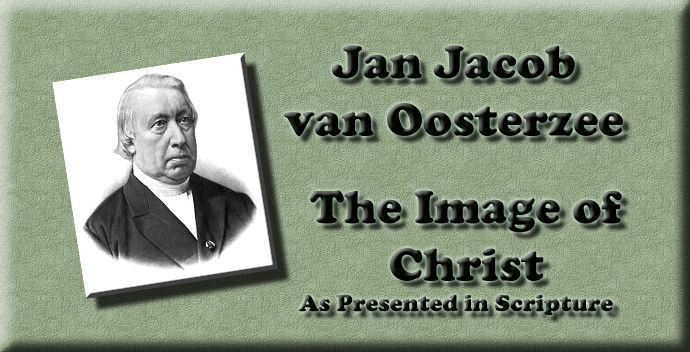
The Image of Christ
As Presented in Scripture
By J. J. Van Oosterzee
Part 2 - Christ in the Flesh
|
ONLY three-and-thirty years does that period embrace, to which this second part of our contemplation is devoted; while on the other hand the former, so far as it was not lost in eternity, extended over a space of not less than four thousand years. Yet the material is here infinitely more plenteous, than that which offered itself there; because we now see the Divine—which we have hitherto contemplated in relation to the finite —henceforth entering into personal communion with humanity. Christ in the flesh! No, we are not surprised that the noblest of our race have so often desired that they might live to see the days in which the Son of God and Son of man here went about in the lowly form of a servant.. Of the most memorable of all histories but comparatively little has been written; over thirty years of it is thrown an impenetrable veil; of the remaining three years, many a day and many a week has fallen into oblivion—and yet the little that we do know awakens an impression of dignity, fulness, and power, which every renewed contemplation serves only to deepen. In fact, it is as a celebrated Theologian of our day writes: “To sound the depths of the history of Jesus is what the most distinguished men have for centuries been seeking after; and even those who are impelled by an undefined influence to seek after truth, without as yet clearly apprehending what they really want, desire at bottom nothing else than to explore these histories. The highest and the deepest, the mightiest and the most tender that humanity has brought forth out of its innermost and truest essence is nothing but the wreath which entwines itself around this sacred stem and its history. At every fresh step forward in the path of this investigation, new depths begin to open themselves up before the thinking mind; with every new progress of the art which will visibly express this ideal, the unattainableness of the ideal makes itself more deeply felt; and if we turn our glance to the silent chamber of devotion, and into the hidden workshops of the science of faith, we see how every height which has been already attained, only serves to lead us in deeper humility to kneel before that Name which is above every name in heaven and earth. If I might call in a comparison to my help, I should point to the vault of heaven, the image of infinite space. The more we are absorbed and lost in the contemplation of the heavens, the more does the conception of end and limit escape us. We take the telescope in hand; we become acquainted with the astonishing calculations of science; the conception of infinite space thereby gains yet more in clearness and fulness; but all serves to this, that we find the final point of all, whence really to survey and measure this space, retreating ever farther from our reach. So is it with the history of the Lord’s life, it makes the impression of infinitude upon us.”1 Yet we must speak of the infinite in the forms of the finite, and the period of which we have here to speak is bounded on the one hand by the moment of the miraculous conception, and on the other by the equally miraculous ascension, of the holy God-man. Naturally, however, we have not here to speak of all the particulars which are the object of express treatment in the Life of Jesus. There indeed we seek, in connection with a purely historic examination, to delineate the Lord trait by trait and thus to show who He was; here, on the contrary, where our contemplation displays a more historico-dogmatic character, we desire especially to make manifest what He was, to sketch in broad outlines His entirely unique dignity and greatness, and to turn our attention., but also to the inner exaltedness of His whole person, in connection with the work accomplished by Him.. This part of our examination is thus necessarily limited to a more general contemplation, and all that we have to present not only to the outward form of His appearing gathers itself around some four prominent main particulars, at which we reverently pause. They are:—
|
|
 |
 |
|
1) Baumgarten, Die Geschichte Jesu, p. 2.
|
|
-
Site Navigation
 Home
Home What's New
What's New Bible
Bible Photos
Photos Hiking
Hiking E-Books
E-Books Genealogy
Genealogy Profile
Free Plug-ins You May Need
Profile
Free Plug-ins You May Need
 Get Java
Get Java.png) Get Flash
Get Flash Get 7-Zip
Get 7-Zip Get Acrobat Reader
Get Acrobat Reader Get TheWORD
Get TheWORD